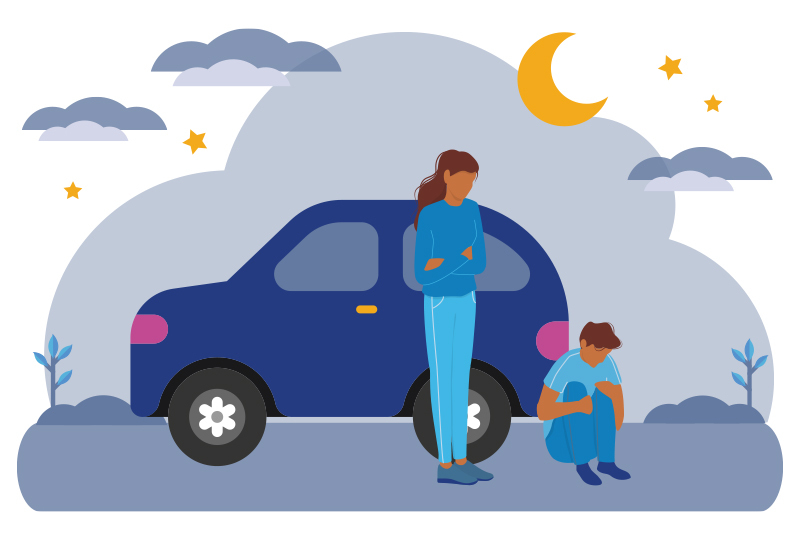When a critically ill child is homeless
(Images: Adobe Stock. Illustration: David Chrisom/Boston Children’s Hospital)
According to government figures, on one night in 2020, about 172,000 families with children and 34,000 unaccompanied young people under the age of 25 were homeless in 2020. Many more families live insecurely amid skyrocketing rents.
A large number of studies show that both situations put children at an increased risk of health problems. Parents may have trouble getting them to primary care or filling prescriptions on a regular basis. Unaddressed medical conditions can escalate into life-threatening emergencies, especially in infants and children with complex medical needs.
To learn more about the effects of homelessness and critical illness in children, Jonathan Gabbay, MD, a pediatrician at Boston Children’s Hospital, worked with critical care physician Katherine Peeler, MD, MA, and Kathryn E. Whyte, LICSW, a social worker at Franciscan Children’s Hospital, to review the medical literature.
They found few explicit studies on the subject. However, the available evidence indicates that once homeless babies and children end up in ICU, they tend to stay longer. Without a stable home environment, children are less able to recover after discharge and are more likely to be re-hospitalized.
Housing insecurity: a hidden problem
Gabbay and his colleagues propose a three-pronged effort to identify and address housing insecurity in critically ill children. Screening is the critical first step, as families may not feel comfortable disclosing this information on their own.
Gabbay himself is an example of this. Fresh out of college, his childhood home was unsafe to return to, so he crashed with kind-hearted relatives or slept in his car. He remembers leaving his dog in the car to go to medical appointments.
“Not many people knew,” he says.
Just looking at someone isn’t a good indicator of whether they’re homeless, Peeler says. At first glance, people with insecure housing seem to have the resources they need. They may have a job and take care of their spouse and children.
“But if you screen for multiple social determinants of health and ask, ‘Do you need help?’ people can say, ‘Yeah, I’m really struggling to pay the rent,’” Peeler says. ‘Or they might say, ‘I can feed my children, but I don’t eat much myself.’ Or, ‘I don’t have reliable access to a car.’”
Step One: Identify Homelessness
Ideally, clinical teams should screen children soon after hospitalization for homelessness or housing insecurity and other social health determinants.
“Evidence shows that many physicians don’t do these screenings, but identifying housing uncertainty early on to plan for transitions is critical,” Gabbay says. “Screening can identify barriers to successful discharge in advance, enabling care teams to meet the needs of the family. Delays in identification could extend children’s stay and increase costs, as children cannot leave hospital without safe housing.”
Screening can be very informative. A recent study led by colleague Kira Bona, MD, MPH, of the Dana-Farber/Boston Children’s Cancer and Blood Disorders Center, tested a series of screening questions for families of children recently diagnosed with cancer. Nearly all families were happy to answer questions about material difficulties—problems paying their rent or mortgage, or paying car, phone, or utility bills, medical bills, or food. More than 40 percent reported “money problems” and 59 percent mentioned problems in more than one area.
Gabbay and Peeler are now developing a screening tool for all children admitted to hospital, asking questions about social determinants of health, including homelessness. Housing-related questions may ask, for example, whether the family is concerned about losing or affording housing, the type of current home, the frequency of family moves in the past 12 months, safety and accessibility of housing, and history of evictions, homelessness, or placement in emergency shelter.
Step two: Layoff planning for homeless children
Ideally, health care teams should begin planning discharges as soon as housing insecurity or homelessness is identified, to ensure children have a safe place to recover that meets their medical needs. Such needs may include:
electricitymedical equipmentroomaccessibilitycleanliness (for infection control)proximity to healthcare providers.
“If a child is sent home with a new diagnosis of diabetes, for example, they need a place with constant electricity to cool insulin,” Peeler says. “Or if they have a new physical disability, they may not be able to get to the fourth-floor walk-up apartment that was previously assigned as their shelter.”
Step three: Care coordination
To minimize readmissions, the researchers urge hospital providers to coordinate care for the child with outpatient medical providers and engage a social worker to help families with housing, utilities, food, and supplemental security income (if the family is eligible). Ambulatory caregivers should be easily accessible to families and should have case managers and social workers on their team.
When interventions start early, it may be possible to finally break the vicious circle in which homelessness leads to ill health and ill health leads to homelessness.
“The more supportive families have once they transition to the outpatient clinic, the more prepared they are for success,” says Gabbay.
Learn about research in the Medical Critical Care program at Boston Children’s Hospital.


Comments are closed.